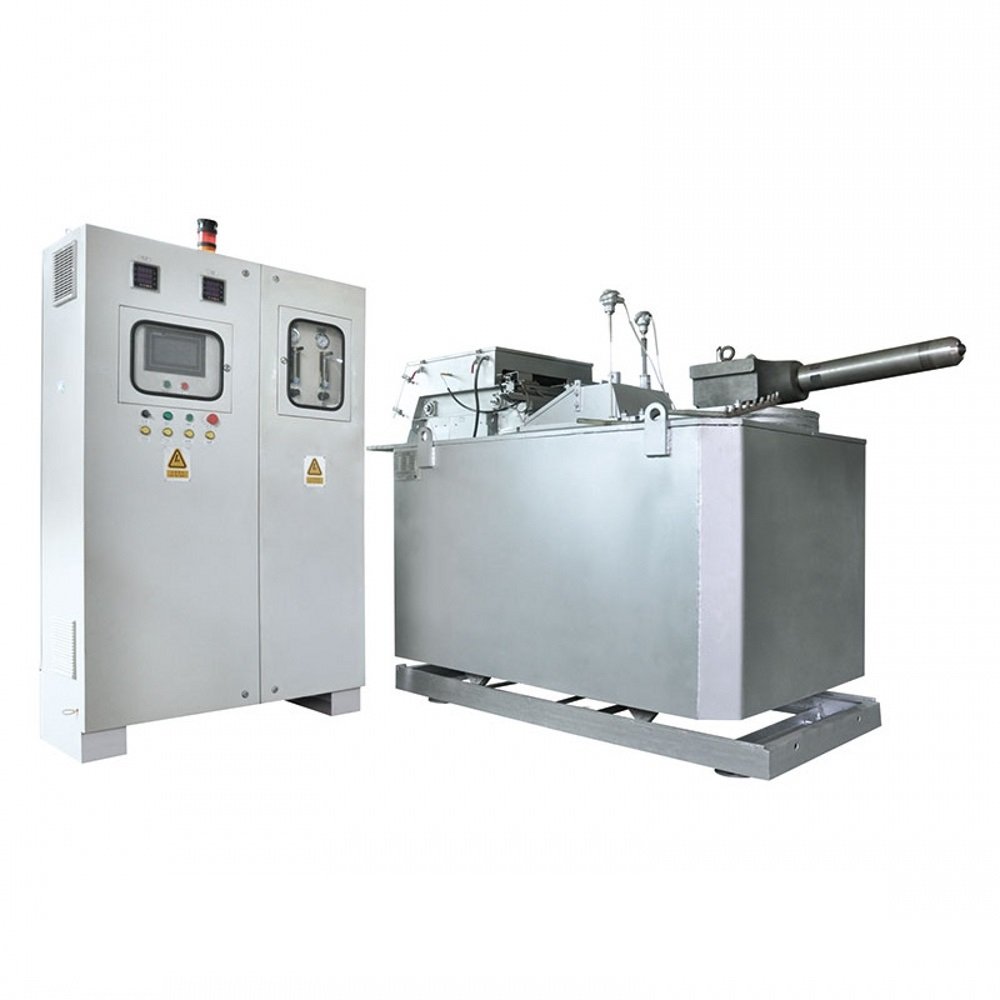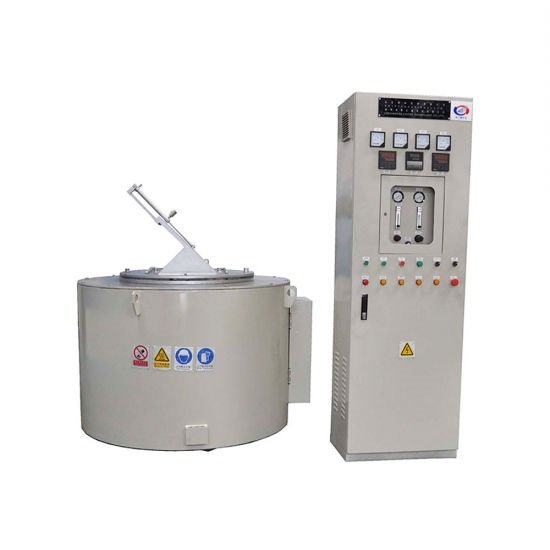Magnesium Alloy Melting Furnace
Casting Metal- Magnesium Alloy Melting Furnace
Magnesium alloy die-casting is different from aluminum alloy die-casting in some aspects. In addition to the special requirements of the die-casting host in some aspects. There are also some differences in the peripheral equipment. For example, magnesium alloy furnaces are different from ordinary aluminum alloy furnaces. In most cases, magnesium alloy die-casting requires a mold temperature controller, and so on. The matching and use of the pickup manipulator and spray manipulator. It can reduce the labor intensity of the operator, improve the working environment and increase work efficiency. The use of peripheral equipment also provides conditions for the realization of automatic production of die casting. It can improve the automatic production level of die-casting production, and reduce the influence of human factors on the die-casting process.
Magnesium alloy melting furnace
As the magnesium alloy is smelted not only to prevent oxidation, but also to have safety measures such as avoiding combustion and explosion. The smelting of magnesium alloys must be carried out in a protective atmosphere. Therefore, magnesium alloy die-casting needs to be equipped with a special furnace, and smelting is also a key link in magnesium alloy die-casting. For the hot chamber machine, in addition to meeting the requirement of higher temperature than the zinc alloy, it must also have a channel for inputting protective gas and a sealing mechanism for the furnace; the cold chamber machine must have a quantitative feeding system.


Gas protection device:
As mentioned earlier, the flame-proof technology of magnesium alloy melting includes salt flux, inhibitory element, inert gas and so on. However, modern die-casting is mainly based on reactive atmosphere. It is also the mainstream and development direction of magnesium alloy die-casting.
Gas protection mechanism:
Magnesium is extremely active in chemical properties and is easily oxidized in the air. MgO is formed on the surface and its density coefficient is 0.79. This loose oxide film cannot prevent the reaction from proceeding. When the temperature exceeds the melting point of 650°C, oxidation quickly transforms into combustion, and a lot of heat is released.
Therefore, the key point of magnesium alloy protection is to isolate the contact between magnesium and oxygen. Although pure N2, Ar, Ne and other gases can prevent the magnesium melt from burning to a certain extent. They cannot completely isolate the magnesium liquid from contact with the surrounding environment, so it does not have a good protective effect.
N2 reacts with magnesium as follows:
3Mg+N2=Mg3N2
The resulting Mg3N2 powdery compound has a loose structure and cannot proceed with the reaction. Although inert gases such as Ar and Ne do not react with the magnesium liquid. They cannot prevent the evaporation of magnesium. Magnesium has formed a certain vapor pressure, will react with the cold wall, so it is not an ideal protective gas.
Commonly Gas Used For Protection
In production, CO2, SO2, SF6 three gases are commonly used can play a good protective effect. And especially SF6 mixed with other gases in a certain proportion of the protection effect is the best.
CO2 and magnesium react as follows at high temperature:
Mg+1/2CO2=MgO+1/2C (amorphous)
The oxidation rate of magnesium liquid in dry and pure CO2 is very low. This is closely related to the appearance of amorphous carbon in the surface film. This amorphous carbon exists in the voids of the oxide film. Which increases the density coefficient of the magnesium surface film to make ɑ=1.03~1.15. The positively charged amorphous carbon can also strongly inhibit the diffusion movement of magnesium ions through the surface membrane. So it can also inhibit the oxidation of magnesium.The reaction of magnesium and SO2 is as follows:
3Mg+SO2=2MgO+MgS
A very thin and dense MgS and MgO composite surface film with metallic luster is formed on the surface of the magnesium melt, which can inhibit the oxidation of magnesium.
Magnesium reacts with the mixed gas containing SF6 as follows:
2Mg(L)+O2=2MgO(S)
2Mg(L)+O2+SF6=2MgF2(S)+SO2F2(S)
2MgO(S)+SF6=2MgF2(S)+SO2F2
The main product is MgO, but also contains a small amount of MgF2. The density factor of MgF2 is 1.6. The mixed film composed of MgO+MgF2 becomes a continuous and dense film, so the atmosphere containing SF6 can prevent the oxidation and combustion of the magnesium alloy melt.
In summary, the flame-retardant mechanism of the protective gas is mainly the reaction of the gas with the magnesium liquid. A surface film with different protective effects is formed on the surface of the melt. These films are dense, can prevent the reaction from proceeding, and can also prevent the evaporation of magnesium liquid. Secondly, the density of these gases is greater than that of air, which insulates the reaction of magnesium and oxygen to a certain extent.
Air mixing device(1)
In actual production, SF6 is often mixed with other gases into the furnace. Commonly used mixing methods are: air/SF6, SF6/N2, air/CO2/SF6. The function of the gas mixing device is to mix these gases accurately according to a certain ratio and then send them into the furnace.
SF6 is a colorless, odorless, non-toxic gas, 4 times heavier than air, and has a chemically inert structure. It is extremely stable at room temperature. Usually, SF6 gas is pressurized to become liquid and stored in a special high-pressure steel cylinder.
Experiments show that 0.01% SF6 concentration can effectively protect magnesium liquid, but the actual concentration used is larger. This is mainly because SF6 will react with magnesium liquid and leak loss. As the input concentration content increases, the SF6 concentration above the liquid level also increases. However, compared with the input concentration, the consumption is increasing.
Therefore, the magnesium alloy melting furnace device must be effectively sealed, so that it is possible to control the SF6 to a certain concentration. Generally, the SF6 concentration should not exceed 1%, at this time not only the antioxidant effect is reduced. Moreover, the atmosphere has a serious corrosive effect on the equipment. Therefore, the optimization of the supply of shielding gas is an important task in system design and operation. The gas mixing device should be able to accurately proportion and mix the gas composition. The concentration and quantity of the shielding gas must be adapted to the melt surface conditions. Achieve low air consumption, while being environmentally friendly, safe and economical.
Air mixing device(2)
SF6 and N2 are mixed together through a pressure reducing valve and a flow control valve. The mixed gas is independently supplied to the pump chamber and the melting chamber through a flow meter. The gas flow of the pump chamber and the melting chamber can be adjusted independently, and the flow of the pump chamber can be controlled at each stage through PLC. For example, the gas flow can be increased during the injection stage, so as to ensure the gas supply more economically and safely. When the shielding gas enters the furnace, it adopts multi-pipe multi-outlet distribution, which is as close to the liquid level as possible and is evenly distributed. In actual production, this kind of gas supply is relatively mature, and the SF6 consumption is also low.
The problem(1)
SF6 is widely used in the production of magnesium alloy die-casting, but there are also some problems. For example, in terms of safety and environmental protection, how to solve these problems is also a topic facing the magnesium alloy industry.
The protective gas may react with the equipment. For example, SF6 reacts with the crucible to form porous FeF3 and Fe2O3. If the concentration of SF6 is too high, the crucible will increase, which will further react violently with the magnesium liquid.
3Mg+Fe2O3=3MgO+2Fe
3Mg+2FeF3=3MgF2+2Fe
The problem(2)
In addition, the reaction may also generate SO2 and SO2F2. It will react with water vapor, and then be absorbed by the skin, further corroding the crucible. The increase in temperature and SF6 concentration will increase the corrosion. So it is necessary to avoid pure SF6 gas from entering the crucible.
Although SF6 gas is non-toxic, it is dense. If there is too much deposition in the workshop, it may cause hypoxia and suffocation. Therefore, the workshop must pay attention to ventilation.
SF6 has a strong ability to absorb long waves. And it stays in the air for a long time, and its greenhouse effect is more significant. The use of SO2 gas is restricted due to its characteristics (toxic gas). Some countries have developed a recycling equipment using SF6. But due to the high cost, the promotion has been restricted to a certain extent. Therefore, the development of a protective gas to replace SF6 is also an urgent problem to be solved in the magnesium alloy industry.
